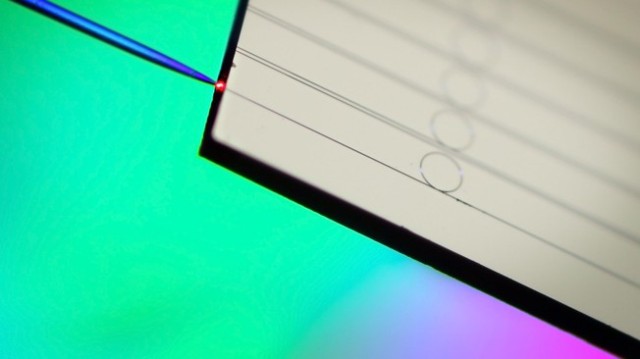Jan 29 2016
Solitons are a type of wave that, unlike other waves, retains its shape even as it moves further away from its source. Soliton waves of light are of great interest because they can produce evenly spaced frequencies of light, like the teeth of comb.
 Ring-shaped silicon nitride microresonators on a chip coupled with an optical fiber © Victor Brasch/Erwan Lucas (EPFL)
Ring-shaped silicon nitride microresonators on a chip coupled with an optical fiber © Victor Brasch/Erwan Lucas (EPFL)
These “frequency combs” can be used in technologies that require widely spaced frequencies, such as telecommunications and chemical analysis. Publishing in Science, researchers led by EPFL have successfully produced light solitons with a small chip-based device, setting a new record in the field.
The project was led by Victor Brasch and Michael Geiselmann at Tobias J. Kippenberg’s lab at EPFL, working with colleagues at the Russian Quantum Center. To generate the solitons, the scientists used microscopic ring-shaped structures made from very fine silicon nitride. These are called “microresonators”, and have been Kippenberg’s expertise for years.
Microresonators are coupled to a laser, and can store light coming from it a few nanoseconds. “This period of time is enough for the light to circumnavigate the ring thousands of times and to accumulate there, which greatly increases the intensity of the light,” explains Kippenberg.
The interaction between the microresonator and the light becomes non-linear. The laser, which is normally continuous by nature, is converted into ultra-short pulses: solitons.
The light is made up of a range of frequencies, which can be thought of as different colors. In the microresonator, the frequencies are separated very precisely by the same distance, producing something that looks like the regular spacing between the teeth of a comb. Consequently, physicists refer to this phenomenon as a “frequency comb”.
By adjusting the microresonator manufacturing parameters, the researchers were also able to generate a so-called “soliton Cherenkov radiation”, which broadens the frequency spectrum; in other words, it allows the comb to have more teeth. At this point, the generated frequencies extend over two thirds of an octave compared with the frequency of the incoming laser (an octave refers to either double or half the frequency).
The achievement sets a new record for this microresonators. "These results represent a promising advance for applications that require many widely spaced frequencies," says Kippenberg, who has already filed a patent.
A field that stands to gain from this work is optical communications. Using this approach, a single laser would be enough to create a range of individual frequencies that could carry information separately, even through the same optical fiber. In addition, chemical spectroscopy and atomic timekeeping are other potential applications.